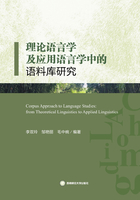
2. Semantic sequence
Corpus investigation helps to reveal regularities in language use. A wide spectrum of recurrent language patternings has been discussed under various guises, such as units of meanings (e.g. Sinclair,1991), lexical bundles(e.g. Biber et al.,2004; Biber&Barbieri,2007), pattern grammar (e.g. Hunston & Francis,2000), and lexical priming(e.g. Hoey,2005). While all these approaches have been shown to be useful for describing the regularities of language in use, they are restricted to the description of formal or structural recurrences [see Hunston (2008:290-292)for a detailed discussion of semantic sequences in relation to these concepts]. An alternative candidate recently proposed to describe regularities of language in use is“semantic sequence”(Hunston,2008), which aims to capture the regularities from a semantic perspective. According to Hunston(2008:271), “Semantic sequences are recurring sequences of words and phrases that may be very diverse in form and which are therefore more usefully characterised as sequences of meaning elements rather than as formal sequences”.
What is particularly relevant to the current investigation is how semantic sequences can be identified. Three methods have been introduced by Hunston (2008)to identify semantic sequences, which are discussed in turn.
The first method is to start with a lexical word or phrase. Hunston(2008)demonstrates this method by taking the item make sure as a starting point to identify semantic sequences[see also Hunston's(2011:112-116)discussion of semantic sequences associated with the fact that]. Looking at concordances of make sure, Hunston observes meaning groups such as Volition (we want to make sure that you don't miss an opportunity), Obligation/necessity/importance (you have to make sure that your children stay close to you), and Possibility(the best way to make sure the arms blends with the shoulders). This method, although of some use for searching semantic sequences in naturally occurring texts, has obvious disadvantages, “the main one being the lack of rigour in the isolation of search terms”(Hunston,2008:277). That is, there appears to be no particular reason why a lexical item or a phrase should be selected as the searching term for identifying semantic sequences. Additionally, this method is inherently unsystematic and, consequently, may not be able to achieve an adequate account of semantic sequences in a specialized corpus.
The second method is to start with grammar patterns (Hunston & Francis,2000). For example, starting with N that and looking at the particular noun-in-pattern exemplar the observation that, Hunston(2008:279)shows that semantic sequences can be identified such as[“theory/argument”+“arises from”+ the observation + that-clause]and [the observation + thatclause +“consistency”+“theory/argument”]. While it has been noted that starting with a grammar pattern“is particularly useful where a pattern is known to be of significance in a given discourse type”(Hunston,2008:292), the usefulness of this method in identifying semantic sequences is currently underexplored. We will return to this below.
The third method is to start with grammatical/small words (e.g. Gledhill,2000). Groom's (2007,2009,2010)investigation in particular indicates the effectiveness of this method for searching semantic sequences and for exploring the association between phraseology and epistemology in contrasting disciplines. His investigation shows that some grammatical words may be salient in one discipline but not in another; for example, against is found salient in History but not in Literary Criticism. Additionally, while some small words may occur saliently in both disciplines, disciplinary differences can be observed; for example, both is found in both disciplines, but both mainly co-occurs with social and political entities in History whereas with textual entities in Literary Criticism.
Despite Hunston (2008)and Groom(2009,2010)have suggested that grammatical words would be a good starting point for identifying semantic sequences, we would argue that the approach of starting with grammar patterns is more promising for searching semantic sequences in academic discourses. This is in fact also consistent with Hunston's(2008)observation. Specifically, while suggesting that grammatical words are the best starting point for identifying semantic sequences, Hunston (2008:272)points out that“grammar patterns form an integral part of semantic sequences”; this clearly indicates the importance of grammar patterns in identifying semantic sequences. Furthermore, Hunston (2008:292)notes that the approach of staring with grammar patterns is particularly useful where a pattern has been shown to be of salience and significance in a given discourse type.
However, the usefulness of grammar patterns for searching semantic sequences has not been sufficiently explored, as noted earlier. We thus aim to showcase how grammar patterns can be used to identify semantic sequences in this study, exemplifying our exploration with a focus on the pattern V that[e.g. argue that, show that; see Francis et al. (1996:97-103)for more exemplification]. Because research has shown that V that occurs quite frequently in academic discourse (Charles,2006a,2006b; Thompson & Ye,1991), we can be confident that sequences identified by analyzing instances of V that would be suggestive and representative of the disciplines under examination.